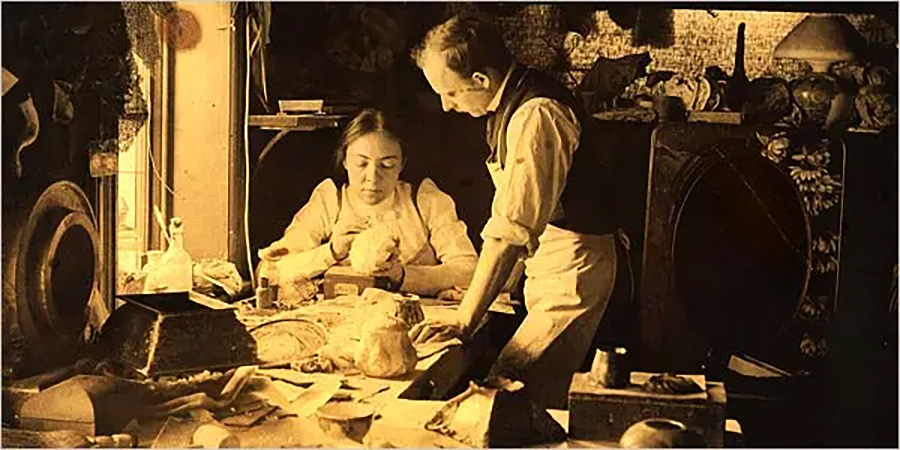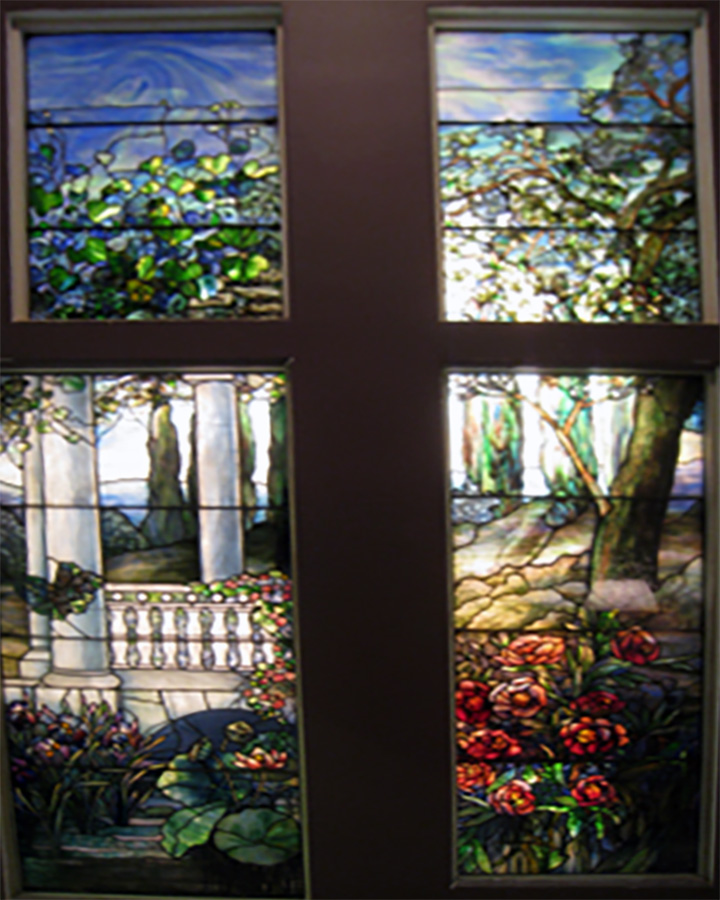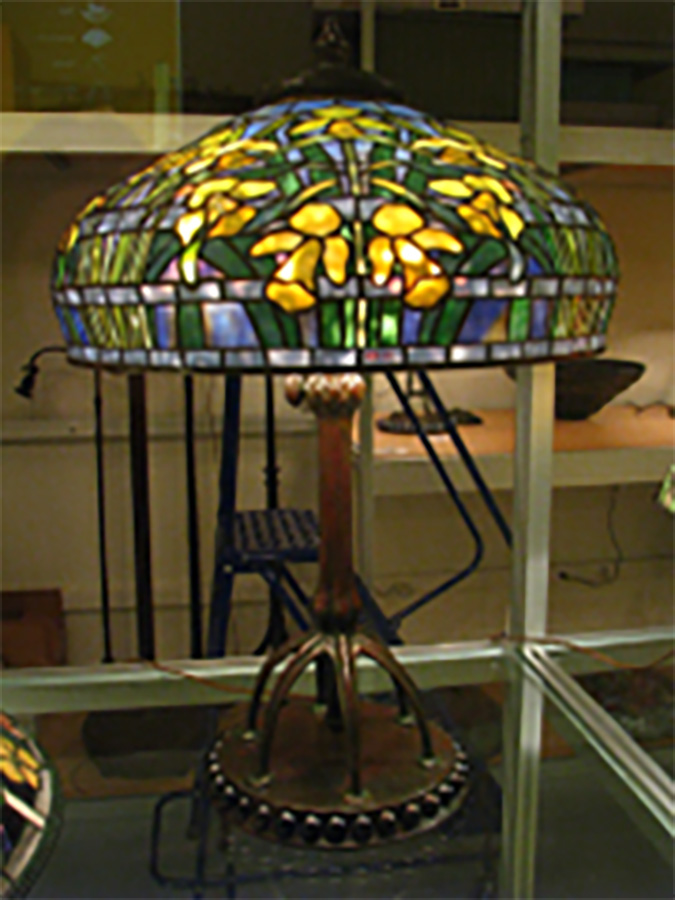Louis Comfort Tiffany from Jelly Jars to Stained Glass by Bill West
This year Tiffany celebrate 175 years of trade and they will focus on their original core business as jewellers. But in the 1950s and 1960s the retrospective focus was on Louis Comfort Tiffany (1848 - 1933) for his contribution to art and design and in particular Tiffany's influence and innovation in the movement Art Nouveau.
Louis wanted to be a painter. He studied landscape and was attracted to European avant-garde artists such as Léon Auguste Adolphe Belly, a French landscape painter and Orientalist. Also, from a young age Louis liked to travel through Europe and Asia and was captivated and inspired by medieval stained glass and Islamic ornamentation. Early seeds of his passion for the kind of sensory overload which would eventually lead to his Romano Byzantine chapel designed for the 1893 Columbian Exposition. This chapel secured his reputation when it was awarded 54 medals.
In addition to his delight in line and colour he was fascinated by light, seeking luminescence in his watercolours. He made a study of glass and the different ways glass could appear lit from within. He spent 30 years of his life attempting to create different qualities in glass such as ancient Roman glass that had been denatured through wear and age. He wanted to manufacture new what only age could produce. It was a science and technique in the glass industry that he found lacking in modern glass making in the States and so it was to Europe and in particular the glass-makers of Stourbridge in England that he turned to. Stourbridge is an area with a 500 year history of glass making. A place that later seeded some of the most successful glass making industries we have today.

Clara Driscoll was the supervisor of the so-called "Tiffany Girls", a team of talented craftswomen. What was not known until recently was that Clara was the designer of some of the most successful Tiffany lamps, such as the daffodil lamp (above) and the dragonfly lamp which had won a prize at the 1900 World’s Fair. Previously these designs had been attributed to Louis Comfort Tiffany. Driscoll had studied design at the Metropolitan Museum Art School and for 20 years was employed by the Tiffany Studios.
As a painter Louis knew how to layer colours on canvas to give depth of tone. With glass he did something similar by layering different coloured glasses to achieve depth, a process called plating and a significant technical and artistic innovation.
Although Tiffany is remembered for his stained glass windows and his vividly coloured leaded glass lamps this was not his sole aim or product. These were just elements of that sensory overload that he sought to create for his wealthy clients. He pursued these effects on many fronts.
Following in the tradition of the Arts & Crafts movement of William Morris in England he sought to bring together in a vast workshop an army of craftsmen and women representing every relevant technique; glass makers, enamellers, embroiderers, weavers, case makers, carvers, gilders, jewellers and cabinet makers -- all working under his direction to fulfil his design brief. Glass-makers like Arthur J. Nash, a talented glass blower from Stourbridge and Clara Driscoll the designer of the famous Daffodil lamp were attracted to Tiffany because he allowed them to develop their skills in a company of artists rather than simply as employees. Tiffany oversaw the work, encouraging whatever fitted his vision for a project, reputedly smashing any work that fell short of that vision. And indeed, any glass item that remained unsold was likely to be smashed, glass returning to the “mix."

As a painter Louis knew how to layer colours on canvas to give depth of tone. With glass he did something similar by layering different coloured glasses to achieve depth, a process called plating and a significant technical and artistic innovation.
Tiffany produced complete interiors including architectural elements such as staircases, bronze windows, mosaics, frescoes and mural paintings, marble inlaying and sumptuous wall hangings in meticulous detail even down to the specific patina effect on metalwork and specific instructions on the reapplication of treatments to maintain the desired effects. His workshops produced quality bespoke interiors.

Bronze lamp with leaded glass shade. Tiffany lamps were often made from pieces of glass discarded from stained glass window work to be re-cut and combined in new and creative ways to produce these stunning designs.
As well as work for the wealthy and influential such as work in the White House for President Chester Alan Arthur there was also a great demand for innovative stained glass to meet an up-swell in demand for ecclesiastical buildings following the Civil War. Louis oversaw the reclamation of centuries-old glass production techniques, patenting different glass products such as the use of metal oxide as a glass colourant and the techniques to produce wrinkled or folded glass surfaces, iridescent glass and 'Lava' glass with a roughened surface. Nash, a talented glass-blower finally produced 'Cypriote' glass, to emulate that same opaque and pitted glass inspired by the ancient Roman glass mentioned earlier. More famous was the so-called “Favrile" glass, a name derived from the Old English word fabrile, meaning "hand-wrought" and renamed by Louis to sound fashionable.
Bronze lamp with leaded glass shade. Tiffany lamps were often made from pieces of glass discarded from stained glass window work to be re-cut and combined in new and creative ways to produce these stunning designs.
Tiffany was not a William Morris yearning for some utopian past. He was happy to seek out the new. In 1885 he worked with Thomas Edison to produce the world's first decorative electric stage lighting for the Lyceum Theatre, New York to stunning effect. Perhaps this, and his ecclesiastical work, is where Louis came closest to making art accessible to common people.
But Louis Comfort Tiffany was too closely aligned to the Art Nouveau movement. In the 1920s when tastes changed he fell out of favour. With the advent of modernity and a movement towards the unadorned and geometric forms of Bauhaus Louis withdrew leaving a vivid but dispersed legacy.